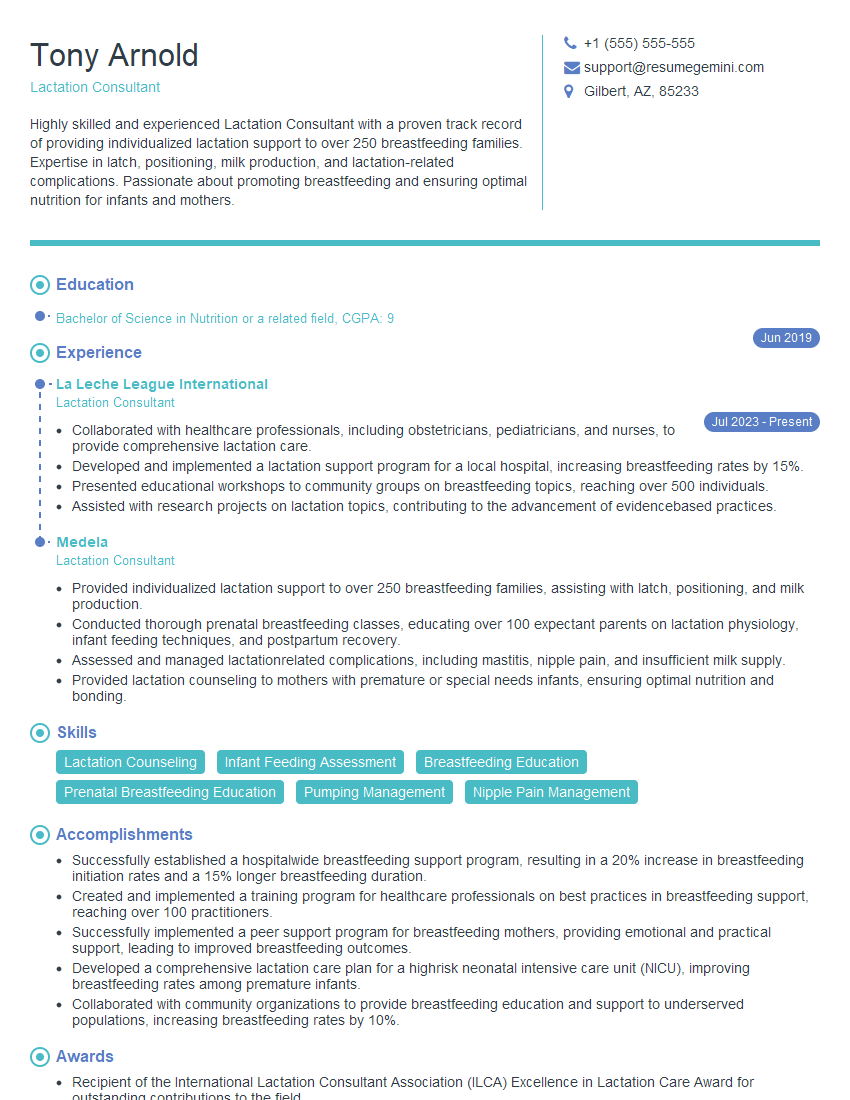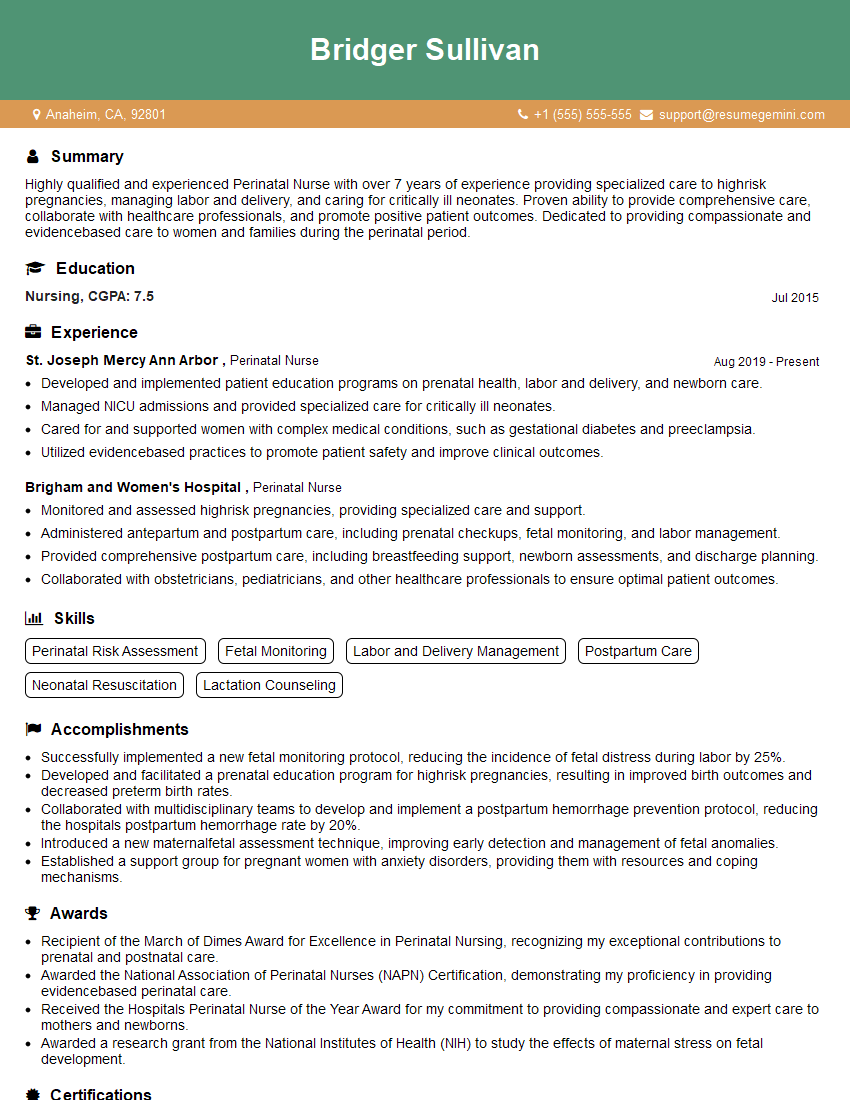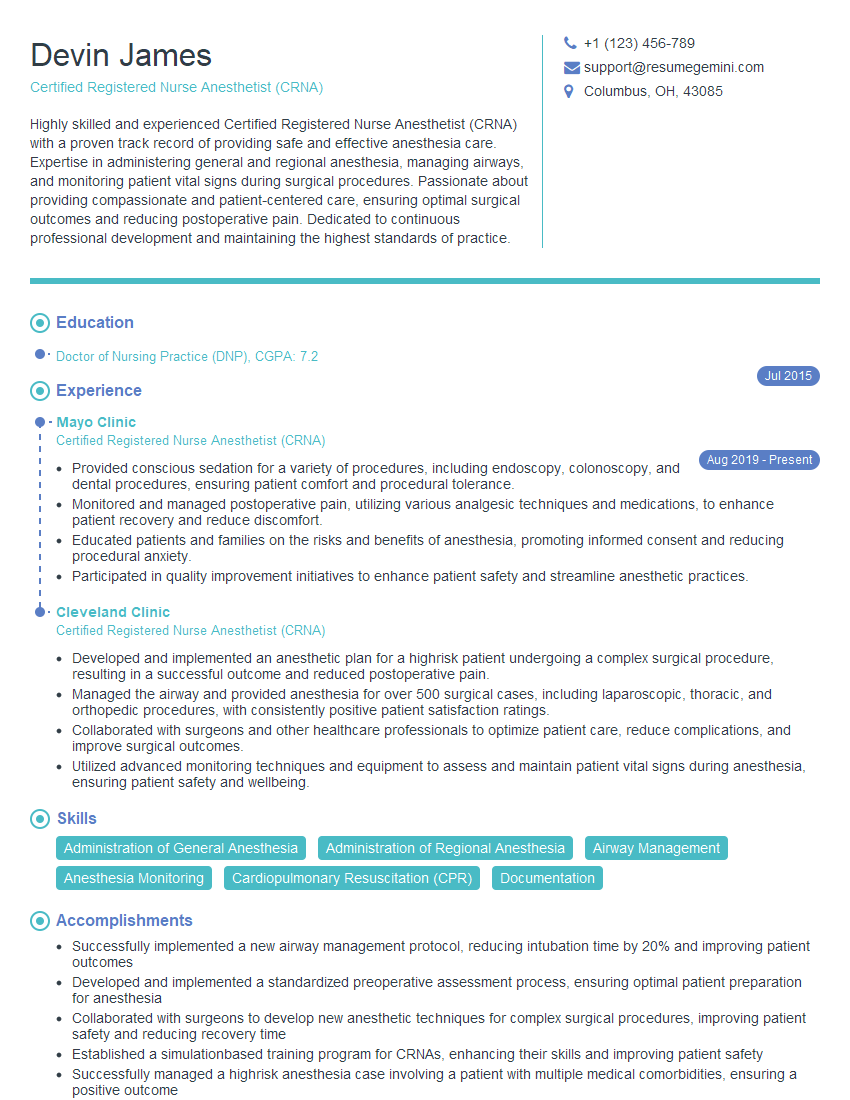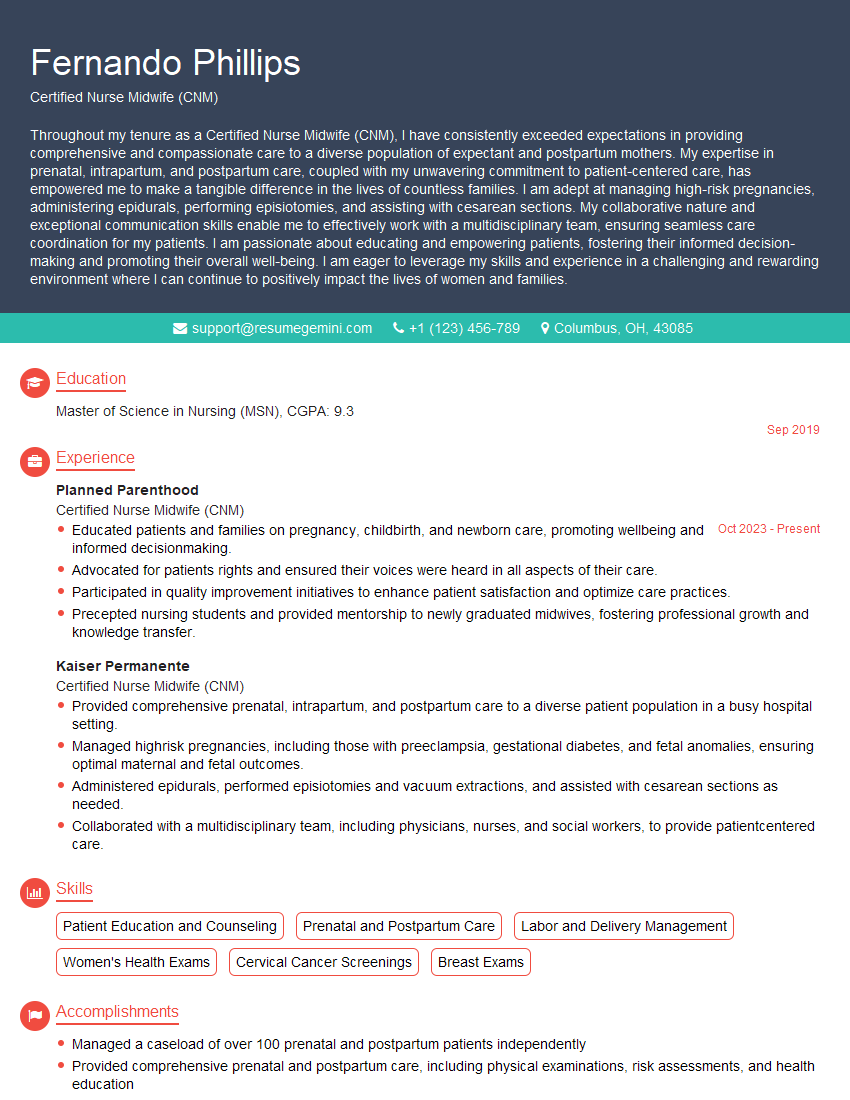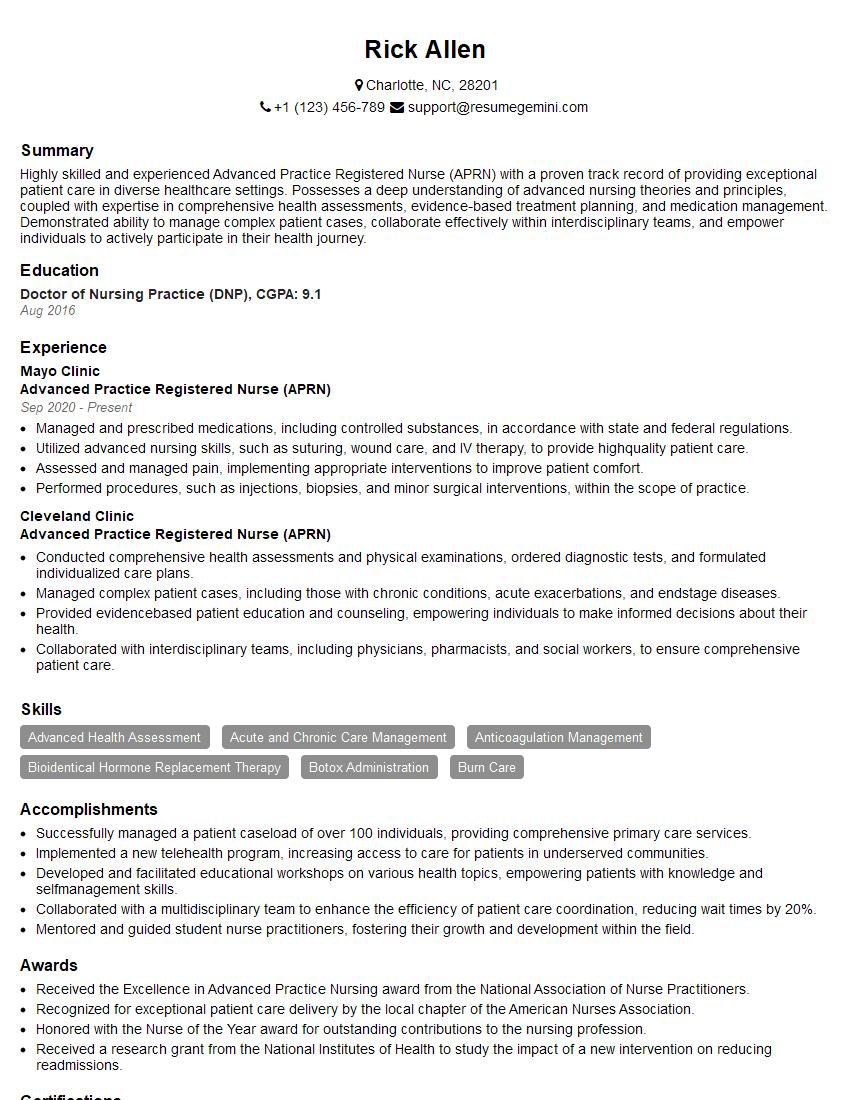Interviews are more than just a Q&A session—they’re a chance to prove your worth. This blog dives into essential Breech Delivery interview questions and expert tips to help you align your answers with what hiring managers are looking for. Start preparing to shine!
Questions Asked in Breech Delivery Interview
Q 1. Describe the different types of breech presentations.
Breech presentation refers to a fetal position where the baby’s buttocks or feet are positioned to exit the birth canal first, instead of the head. There are three main types:
- Frank breech: The baby’s buttocks present first, with the legs extended upwards towards the face.
- Complete breech: The baby’s buttocks present first, with the legs flexed (bent) at the hips and knees, often in a folded position.
- Footling breech: One or both feet present first. This is considered the most risky type.
Understanding these variations is crucial for determining the optimal delivery method. For instance, a frank breech might be amenable to vaginal delivery under specific circumstances, while a footling breech often necessitates a Cesarean section.
Q 2. Explain the risks associated with breech delivery.
Breech delivery carries several significant risks for both the mother and the baby. For the baby, these include:
- Umbilical cord compression: The baby’s head is the last to deliver, meaning the umbilical cord can be compressed during the process, reducing oxygen supply.
- Head trauma: The baby’s head may experience trauma during delivery due to its size and the difficulty of navigating the birth canal.
- Fractured bones: Bones in the shoulders, arms, or clavicle might be fractured during delivery.
- Birth asphyxia: Reduced oxygen supply during labor can lead to birth asphyxia, causing brain damage or death.
Maternal risks encompass:
- Prolonged labor: Breech deliveries often take longer than head-first deliveries.
- Postpartum hemorrhage: Increased risk of excessive bleeding after delivery.
- Uterine rupture: In rare cases, the uterus can rupture during delivery.
These risks underscore the importance of careful monitoring and management of breech pregnancies.
Q 3. What are the indications for external cephalic version (ECV)?
External cephalic version (ECV) is a procedure where the doctor attempts to turn the baby from a breech position to a head-down position before labor begins. It’s indicated in situations where:
- The pregnancy is at term (37 weeks or more).
- The baby is not engaged in the pelvis (head is not yet firmly in the birth canal).
- There are no contraindications (discussed in the next question).
- The mother is willing to undergo the procedure.
ECV offers a chance to avoid Cesarean section, although it is not always successful. Success rates vary depending on the gestational age, the type of breech presentation and the skill of the physician.
Q 4. What are the contraindications for ECV?
Several factors contraindicate ECV. These include:
- Previous Cesarean section: Increased risk of uterine rupture.
- Multiple gestation (twins or more): Increased risk of complications for both mother and babies.
- Placenta previa or abruptio placentae: Conditions involving the placenta increasing the risk of severe bleeding.
- Oligohydramnios (low amniotic fluid): The baby might be difficult to maneuver or risk cord compression.
- Uterine anomalies: Structural abnormalities of the uterus.
- Fetal abnormalities: Conditions like fetal distress.
- Previous uterine scar that is not from a low transverse Cesarean section incision.
Careful assessment is necessary to determine the suitability of ECV; it’s a procedure with potential risks, therefore, it’s contraindicated in situations that heighten the chance of complications.
Q 5. Outline the steps involved in performing a vaginal breech delivery.
Vaginal breech delivery is a complex procedure performed only by experienced healthcare providers. It’s a controlled descent of the baby, and the steps involve:
- Preparation: Thorough assessment of the mother and baby, appropriate pain management, and establishing a plan.
- Delivery of the buttocks and legs: Gentle downward traction during contractions.
- Delivery of the shoulders: Careful maneuvers to prevent injury to the baby’s shoulders and clavicles.
- Delivery of the head: This is the most crucial and potentially risky step. Various techniques are used, depending on the presentation and the position of the baby’s head.
- Immediate postpartum care: Close observation of both the mother and the baby for complications.
It’s important to emphasize that successful vaginal breech delivery requires a skilled team and close monitoring to minimize complications. Not all breech presentations are suitable for vaginal delivery.
Q 6. What are the potential complications of vaginal breech delivery?
Vaginal breech delivery, even when skillfully performed, carries the potential for complications. These include:
- Umbilical cord compression and asphyxia: As mentioned before, this is a serious risk.
- Birth injuries: Fractured clavicles, brachial plexus injuries, and head trauma are possibilities.
- Postpartum hemorrhage: Excessive bleeding after delivery.
- Uterine rupture: Although rare, it’s a life-threatening complication.
- Perineal lacerations: Tears in the tissues between the vagina and the anus.
These complications highlight the importance of skilled personnel and appropriate facilities for vaginal breech deliveries.
Q 7. When is a Cesarean section indicated for a breech presentation?
Cesarean section is the preferred method of delivery in most breech presentations. It’s indicated in numerous scenarios, including:
- Footling breech: Increased risk of umbilical cord prolapse and fetal distress.
- Incomplete breech: Difficulty in manipulating the baby’s position during delivery.
- Macrosomia (large baby): Difficult vaginal delivery due to the baby’s size.
- Fetal distress: Any sign of compromised fetal well-being.
- Maternal factors: Conditions like previous uterine surgery or a compromised cardiac state.
- Lack of experienced personnel to manage a vaginal breech delivery: Safety and the experience of the practitioner are critical factors in breech management
In summary, Cesarean section significantly reduces the risks associated with vaginal breech delivery in most situations.
Q 8. Discuss the role of ultrasound in assessing breech presentation.
Ultrasound plays a crucial role in diagnosing and assessing breech presentation. It allows for visualization of the fetal position, determining whether it’s a frank, complete, or incomplete breech. This is essential for guiding management decisions. The sonographer can identify the fetal lie (relationship of the long axis of the fetus to the long axis of the mother), presentation (the fetal part presenting in the pelvis), and position (the relationship of a designated fetal landmark to the maternal pelvis). For example, a complete breech shows the hips and knees flexed, while a frank breech shows the hips flexed and the knees extended. Ultrasound also helps assess fetal growth, amniotic fluid levels, and placental location, which are all critical factors in determining the safest birthing plan.
Beyond initial assessment, ultrasound can be used throughout pregnancy to monitor fetal growth and position, especially in late pregnancy, to see if the baby has spontaneously turned. Serial ultrasounds are often recommended for breech presentations to track changes and aid in shared decision-making between the obstetrician and the expectant mother.
Q 9. Explain the importance of fetal monitoring during breech delivery.
Continuous fetal monitoring is paramount during breech delivery because it allows for real-time assessment of the fetal heart rate (FHR). This is crucial for detecting any signs of fetal distress, such as decelerations or bradycardia, which can indicate hypoxia (lack of oxygen). Any abnormalities in the FHR necessitate immediate intervention to ensure fetal well-being. Intrapartum monitoring can involve external methods (ultrasound Doppler) and internal methods (fetal scalp electrodes), allowing for a more nuanced appreciation of fetal response to labor. During a breech delivery, there’s an increased risk of umbilical cord compression, which can lead to fetal distress. Continuous monitoring allows for early detection and appropriate management of such events. For example, a sudden drop in FHR during delivery might prompt an expedited delivery or other supportive measures.
Q 10. Describe the management of shoulder dystocia in a breech delivery.
Shoulder dystocia, where the baby’s shoulders get stuck after the head is delivered, is a serious complication in any delivery, including breech deliveries. Management involves a series of maneuvers designed to dislodge the impacted shoulder and deliver the baby safely. The McRoberts maneuver (maternal hip hyperflexion) and suprapubic pressure are often tried first. If these fail, more advanced techniques may be necessary, such as Woods corkscrew maneuver or delivery of the posterior shoulder.
The key is to act swiftly and systematically. The birthing team needs to be prepared and have a clear plan, including the immediate availability of neonatal resuscitation equipment. In severe cases, where these maneuvers fail, the obstetrician may consider a symphysiotomy (a surgical incision into the pubic symphysis) or even a Cesarean section to prevent severe complications for both the mother and the baby. Documentation of all maneuvers and their timing is crucial for quality of care and learning.
Q 11. How do you manage umbilical cord prolapse during a breech delivery?
Umbilical cord prolapse, where the umbilical cord descends before the presenting part, is a life-threatening emergency during breech delivery. The compression of the cord can severely compromise fetal oxygenation. Immediate management is critical. The first step is to relieve the pressure on the cord. This is typically done by elevating the presenting part (the baby’s buttocks in this case) using a sterile hand, while simultaneously administering oxygen to the mother and preparing for an emergency Cesarean delivery. This minimizes cord compression and increases oxygen supply to the fetus. The aim is to prevent prolonged cord compression and deliver the baby quickly.
While attempting to relieve the pressure, the birthing team will work efficiently to prepare for a Cesarean section. Delay in this action would have dire consequences. This is an example where rapid and well-coordinated teamwork between the obstetrician, anesthesiologist, and nursing staff is paramount.
Q 12. What are the neonatal risks associated with breech delivery?
Breech deliveries carry a higher risk of neonatal complications compared to cephalic (head-first) deliveries. These include:
- Birth injuries: Fractures of the clavicle or humerus, brachial plexus palsy (nerve damage affecting the arm), and intracranial hemorrhage are all possibilities due to the unusual mechanics of delivery.
- Respiratory problems: Meconium aspiration syndrome (inhalation of meconium, the baby’s first stool) is more common in breech births, potentially leading to respiratory distress.
- Hypoxia: Cord compression during delivery can cause decreased oxygen to the baby, resulting in hypoxia and potential neurological damage.
- Perinatal mortality: Though rare, breech deliveries are associated with an elevated risk of perinatal death compared to vertex births.
The severity of these complications depends on several factors including the type of breech presentation, the skill of the attending staff, and the availability of appropriate neonatal resuscitation equipment. Post-natal monitoring is essential in breech deliveries to identify and manage any potential complications.
Q 13. What are the maternal risks associated with breech delivery?
Maternal risks associated with breech delivery are also significant and include:
- Prolonged labor: Breech deliveries often lead to longer and more arduous labor processes.
- Postpartum hemorrhage: Increased risk of bleeding after delivery due to uterine atony (poor contraction of the uterus).
- Uterine rupture: Though uncommon, this is a serious complication with potentially fatal consequences.
- Perineal trauma: The risk of vaginal tears and other perineal injuries is considerably higher compared to vertex births.
- Cesarean delivery: Many breech presentations result in Cesarean sections, which carries its own set of risks, such as infection and wound complications.
Careful monitoring during labor and a well-prepared birthing team are crucial to minimize the risks for the mother.
Q 14. Discuss the role of the birthing team during a breech delivery.
A skilled and coordinated birthing team is absolutely essential for successful breech delivery. The team typically comprises:
- Obstetrician: Leads the delivery, performing necessary maneuvers and managing any complications.
- Anesthesiologist: Provides anesthesia if necessary (e.g., for a Cesarean section or pain relief).
- Neonatal team: Ready for immediate resuscitation and stabilization of the newborn.
- Midwives or nurses: Assist the obstetrician, monitor fetal heart rate, and provide emotional support to the mother.
Effective communication and collaboration among all members of the team are critical. A pre-determined plan that includes contingency measures for possible complications like shoulder dystocia or umbilical cord prolapse should be in place. Regular briefings between team members throughout the delivery are important for a cohesive approach to ensuring a positive outcome for both the mother and the baby.
Q 15. Explain the importance of informed consent in breech delivery decisions.
Informed consent in breech delivery is paramount. It means the pregnant person understands the risks and benefits of both vaginal breech delivery and Cesarean section, and makes a decision based on that understanding, free from coercion. This process isn’t just about signing a form; it’s a collaborative discussion involving shared decision-making between the healthcare provider and the patient. We ensure the patient understands the potential complications of each delivery method, such as the increased risk of fetal distress, perineal trauma, or the need for assisted delivery in vaginal breech deliveries, versus the risks associated with Cesarean section, such as infection, bleeding, and longer recovery time. The discussion also encompasses the patient’s preferences, values, and any anxieties they may have. Without informed consent, any intervention, including a Cesarean section, would be unethical.
Career Expert Tips:
- Ace those interviews! Prepare effectively by reviewing the Top 50 Most Common Interview Questions on ResumeGemini.
- Navigate your job search with confidence! Explore a wide range of Career Tips on ResumeGemini. Learn about common challenges and recommendations to overcome them.
- Craft the perfect resume! Master the Art of Resume Writing with ResumeGemini’s guide. Showcase your unique qualifications and achievements effectively.
- Don’t miss out on holiday savings! Build your dream resume with ResumeGemini’s ATS optimized templates.
Q 16. How do you counsel a patient about the risks and benefits of vaginal breech delivery versus Cesarean section?
Counseling a patient about breech delivery involves a thorough explanation of both options. For vaginal breech delivery, I explain that while it’s possible, it’s associated with higher risks of complications for both the mother and baby compared to a cephalic (head-first) delivery. These risks include umbilical cord compression, fetal hypoxia (lack of oxygen), perineal trauma (tears), and the need for assisted delivery using forceps or vacuum. On the other hand, I discuss the benefits of a vaginal delivery, such as quicker recovery, less pain medication generally needed, and less risk of infection compared to a Cesarean section. For Cesarean section, I explain that this is generally the safer option for both mother and baby in a breech presentation, significantly reducing the risks mentioned above. However, I detail the potential risks associated with a Cesarean: increased risk of postpartum hemorrhage, infection, blood clots, and prolonged recovery time. The decision ultimately rests with the patient, informed by a balanced understanding of the potential outcomes of both choices. I find it helpful to use visual aids, such as diagrams or sonograms, to illustrate the different positions and potential challenges.
Q 17. Describe your experience with assisting in or managing breech deliveries.
Throughout my career, I’ve been involved in numerous breech deliveries, both assisting and leading the procedure. I’ve witnessed successful vaginal breech deliveries, often utilizing techniques like the Mauriceau-Smellie-Veit maneuver (a specific method for extracting the baby’s head). However, I’ve also been part of situations where, despite meticulous assessment and planning, a Cesarean section became necessary due to fetal distress or other unforeseen complications. One particularly memorable case involved a patient who strongly desired a vaginal birth. After careful assessment and discussion, we attempted a vaginal delivery. While it progressed well initially, we encountered shoulder dystocia (difficulty delivering the shoulders), which necessitated immediate intervention and ultimately resulted in a Cesarean section to ensure both maternal and fetal safety. This case underscored the importance of continuous monitoring and the necessity of having a clear plan for managing potential complications.
Q 18. What are the key elements of postnatal care following a breech delivery?
Postnatal care following a breech delivery, whether vaginal or Cesarean, focuses on close monitoring of both the mother and the baby. For the mother, this includes assessing for postpartum hemorrhage, infection, pain management, and emotional well-being. Regular checks of vital signs, wound healing (if a Cesarean was performed), and addressing potential complications are crucial. For the baby, careful monitoring is necessary to identify potential complications like respiratory difficulties, hypothermia, or jaundice, particularly in those born via vaginal breech delivery due to the increased risk of trauma during delivery. Furthermore, providing education and support to the parents on newborn care, breastfeeding, and addressing any concerns are integral parts of postnatal care. We often schedule follow-up appointments to ensure a smooth recovery and address any arising questions or issues.
Q 19. What are some common misconceptions about breech delivery?
Common misconceptions about breech delivery often revolve around the inevitability of a Cesarean section. Many believe that all breech presentations necessitate a Cesarean, but this isn’t true. Vaginal breech delivery is possible, though it carries higher risks and requires an experienced healthcare team. Another misconception is that vaginal breech delivery is inherently more dangerous than a Cesarean. While the risks are higher, a Cesarean also carries its own set of potential complications. Finally, some believe that the position of the baby can’t be changed late in pregnancy, while External Cephalic Version (ECV), a procedure to turn the baby, can sometimes be successful, though it’s not always feasible or risk-free. Addressing these misconceptions through clear and compassionate communication is essential in ensuring informed decision-making.
Q 20. How do you assess fetal well-being during a breech delivery?
Fetal well-being during a breech delivery is continuously monitored using electronic fetal monitoring (EFM) to assess the fetal heart rate. We look for patterns that indicate fetal distress, such as decelerations (slowing of the heart rate) or tachycardias (rapid heart rate). Continuous monitoring allows for prompt identification and intervention if necessary. In addition to EFM, we might also use intermittent auscultation (listening to the fetal heart rate with a stethoscope) to supplement the electronic monitoring. The mother’s vital signs and the progress of labor are also closely monitored to identify any potential complications that could affect the fetus. The combination of these assessments helps us make informed decisions about the management of the delivery, ensuring the safety of both the mother and the baby.
Q 21. What are the current guidelines and recommendations for managing breech pregnancies?
Current guidelines and recommendations for managing breech pregnancies emphasize shared decision-making between the healthcare provider and the pregnant person. The approach is individualized based on factors such as gestational age, fetal size, maternal history, and the presence of any other complications. While vaginal breech delivery remains an option for certain low-risk pregnancies, Cesarean section is generally recommended as the safer option for most breech presentations, especially in situations involving macrosomia (large baby), previous Cesarean section, or any other risk factors. The use of ECV is considered in some cases, but it should be performed by an experienced clinician and the risks and benefits must be thoroughly explained to the pregnant person. These guidelines are continually reviewed and updated as new evidence becomes available.
Q 22. Describe your experience with different breech delivery techniques.
Breech delivery, where the baby is born bottom-first or feet-first, requires specialized techniques due to the increased risk of complications. My experience encompasses both vaginal breech delivery attempts (with careful consideration of maternal and fetal well-being) and Cesarean sections, the most common and often safest approach for breech presentations. Specific techniques for vaginal breech delivery I’ve utilized include:
The external cephalic version (ECV): This involves attempting to manually turn the baby to a head-down position before labor begins. It’s a procedure I only attempt when the gestational age, fetal size, and maternal conditions are favorable and with informed consent.
Assisted vaginal breech delivery: If ECV fails and vaginal delivery is deemed safe, this involves careful manual maneuvers to guide the baby out, often requiring skilled assistance to deliver the head, the most challenging part. This necessitates constant monitoring of fetal heart rate and careful consideration of potential complications such as shoulder dystocia and umbilical cord compression.
Total breech extraction: In this approach, the baby is delivered entirely by the doctor’s controlled traction. This approach is reserved for rare situations where the baby’s head remains stuck after the body has been delivered and requires specialized training and an experienced team.
My experience in performing and assisting in these techniques has equipped me with the knowledge and skill to manage a wide spectrum of breech presentations, prioritizing both maternal and neonatal safety. The choice of technique is always guided by careful assessment of the individual circumstances.
Q 23. How do you handle unexpected complications during a breech delivery?
Unexpected complications during breech delivery can be life-threatening for both mother and baby, demanding immediate and decisive action. My approach centers around rapid assessment, decisive intervention, and seamless communication with the surgical team. For instance:
Umbilical cord prolapse: If the cord precedes the baby, immediate intervention is critical to prevent fetal hypoxia. This requires elevation of the presenting part (often with a hand), prompt delivery of the baby (often by Cesarean section), and potentially resuscitative measures.
Shoulder dystocia: This refers to difficulty delivering the shoulders after the head is born. Recognition is critical, and various maneuvers (McRoberts maneuver, suprapubic pressure) may be used to resolve it. If these fail, immediate Cesarean section is necessary.
Fetal distress: Continuous fetal monitoring is paramount. Decelerations in fetal heart rate indicate compromised oxygen supply, often requiring immediate action, including Cesarean section to secure a rapid delivery.
A critical component is the ability to quickly assess the situation and decide on the most appropriate course of action. My experience helps me make swift decisions that prioritize the safety of both the mother and the infant, often involving immediate transfer to the operating room for emergency Cesarean section if needed.
Q 24. What is your approach to preventing complications during a breech delivery?
Preventing complications during breech delivery starts with meticulous prenatal care and a thorough assessment of the pregnancy. My approach includes:
Careful ultrasound evaluation: Identifying the breech presentation early allows for discussion of options and planning for delivery, potentially including an external cephalic version (ECV).
Appropriate timing of delivery: A discussion to determine the optimal timing for delivery, balancing the risks associated with prematurity and the risks of prolonged breech pregnancy, is crucial.
Thorough patient education: Understanding the risks and benefits of various delivery methods empowers the mother to make informed decisions. This includes clearly outlining the potential advantages and disadvantages of vaginal delivery vs. Cesarean section for her specific situation.
Availability of experienced personnel and equipment: Having a skilled medical team and readily available resources (e.g., anesthesia, operating room) minimizes response time in case of emergencies.
Careful planning and proactive management minimize the risk of complications. Early detection of any potential issues allows the necessary steps to be taken promptly to ensure a safe delivery for both mother and child.
Q 25. How do you assess the need for instrumental assistance during a breech delivery?
The decision to use instrumental assistance during a breech delivery is carefully evaluated, considering the risks and benefits for both mother and baby. I assess the need based on several factors:
Fetal heart rate monitoring: Non-reassuring fetal heart rate patterns strongly suggest the need for immediate intervention, often involving vacuum or forceps to expedite delivery.
Maternal exhaustion: Prolonged labor can exhaust the mother, and instrumental assistance may become necessary to avoid maternal or fetal compromise.
Failure to progress: If the baby is not descending adequately, despite maternal pushing efforts, instrumental assistance may be considered.
Head entrapment: If the baby’s head gets stuck during delivery, prompt instrumental assistance is usually required to avoid complications.
The decision to use instrumentation is made on a case-by-case basis, carefully weighing the risks of instrumental delivery (e.g., trauma to the mother or baby) against the risks of delayed delivery. If there’s any significant concern regarding fetal well-being, Cesarean section often takes precedence.
Q 26. What are the indications for performing a planned Cesarean section for a breech presentation?
A planned Cesarean section for breech presentation is often the safest option, and I recommend it in several situations:
Macrosomia (large baby): A large baby increases the risk of complications during vaginal delivery, including shoulder dystocia and other birth injuries.
Previous Cesarean section: Women with previous Cesarean sections are at higher risk of uterine rupture during vaginal delivery, making Cesarean section the preferred method.
Fetal anomalies: Birth defects or abnormal fetal presentations may increase the risk of complications during vaginal delivery, making Cesarean section a safer alternative.
Uterine abnormalities: Anomalies in the shape or size of the uterus can make vaginal delivery difficult or risky.
Maternal medical conditions: Conditions like heart disease or severe hypertension may necessitate a Cesarean section to ensure maternal safety.
Failure to convert from a breech presentation despite attempts at ECV: If the external cephalic version fails, a planned Cesarean section is often deemed the safest approach.
The decision is always made in consultation with the mother and after a thorough assessment of both maternal and fetal conditions, aiming for the safest possible outcome for both.
Q 27. Discuss the ethical considerations involved in making decisions about breech delivery.
Ethical considerations in breech delivery decisions are paramount. The core principle is shared decision-making, ensuring the mother’s autonomy in choosing the best course of action for her and her baby. This involves:
Informed consent: Providing the mother with complete and unbiased information about the risks and benefits of both vaginal delivery and Cesarean section is crucial. This includes clear explanations of the potential complications associated with each approach.
Respect for maternal preferences: While offering my medical expertise, I respect the mother’s wishes as long as they are not medically contraindicated. Open communication is vital to ensure her values and concerns are heard.
Balancing risks and benefits: The decision should be based on a careful evaluation of the risks and benefits for both mother and baby, considering the specific circumstances of the pregnancy.
Transparency and honesty: Openly discussing the limitations of my knowledge and the uncertainties inherent in any birth process is essential for building trust.
Ethical considerations require that I prioritize the well-being of both mother and child, always advocating for the safest and most appropriate approach while respecting the mother’s autonomy and informed consent.
Key Topics to Learn for Breech Delivery Interview
- Fetal Presentation and Positioning: Understanding the different types of breech presentations (frank, complete, footling) and their implications for delivery.
- Risk Assessment and Management: Identifying potential risks associated with breech delivery and implementing appropriate management strategies, including the role of ultrasound.
- External Cephalic Version (ECV): Understanding the procedure, indications, contraindications, success rates, and potential complications.
- Planned Cesarean Section vs. Vaginal Breech Delivery: Weighing the risks and benefits of each approach based on maternal and fetal factors.
- Techniques for Vaginal Breech Delivery: Familiarizing yourself with different techniques (e.g., Mauriceau-Smellie-Veit maneuver) and their appropriate application.
- Post-Delivery Care: Understanding the potential complications and necessary monitoring for both mother and infant following a breech delivery.
- Neonatal Resuscitation: Knowledge of neonatal resuscitation techniques, particularly relevant given the increased risk of complications in breech deliveries.
- Ethical Considerations: Understanding the ethical considerations surrounding decision-making in breech deliveries, including shared decision-making with parents.
- Evidence-Based Practice: Staying current with the latest research and guidelines on breech delivery management.
- Case Studies and Scenario Analysis: Preparing to discuss real-world scenarios and apply your knowledge to solve practical problems.
Next Steps
Mastering the complexities of breech delivery demonstrates a high level of skill and expertise, significantly enhancing your career prospects in obstetrics and gynecology. A well-crafted resume is crucial for showcasing this expertise to potential employers. Creating an ATS-friendly resume is essential to ensuring your application gets noticed. ResumeGemini is a trusted resource for building professional and impactful resumes. They offer examples of resumes tailored to the specific needs of professionals in Breech Delivery, helping you present your qualifications effectively. Take advantage of these resources to elevate your job search and secure your dream position.
Explore more articles
Users Rating of Our Blogs
Share Your Experience
We value your feedback! Please rate our content and share your thoughts (optional).
What Readers Say About Our Blog
This was kind of a unique content I found around the specialized skills. Very helpful questions and good detailed answers.
Very Helpful blog, thank you Interviewgemini team.
